#Portrait of Cecilia Gallerani
Explore tagged Tumblr posts
Text
Photo © by Amber Maitrejean, of a display on the grounds of Clos Lucé, a château in Amboise, France.
Clos Lucé was the official residence of Leonardo da Vinci from 1516 until his death in 1519. Images of Leonardo's works printed on sheer panels seem to merge with the lush garden.
I believe the two shown here are details from (left) the Louvre's version of 'The Virgin of the Rocks,' and (right) 'Portrait of Cecilia Gallerani (Lady with an Ermine).'

#Amber Maitrejean#photograph#Clos Lucé#château#france#Leonardo da Vinci#The Virgin of the Rocks#Portrait of Cecilia Gallerani#Lady with an Ermine#Artworks#art and soul
8 notes
·
View notes
Text




LADY WITH AN ERMINE /1490/ by LEONARDO DA VINCI
It is one of only four female portraits that Leonardo painted during his lifetime. The woman holding the ermine, or weasel, has been identified as Cecilia Gallerani, the mistress of the Duke of Milan, Ludovico Sforza, who Leonardo was working for at the time. She was just 16 years old at the time it was painted and was one of Leonardo’s closest female friends.
Different parts of this painting have been retouched over the years. The background has been darkened, which obscured a door that was originally present. Cecilia’s hair has been lengthened. The shadows between her fingers on her hand have been darkened. Her dress has been darkened as well.
Many aspects of this painting make it revolutionary and further support just how genius Leonardo was. First off, this oil painting was done in the very first years following the invention of oil as a medium. It appears that by this time, Leonardo had not only taken to the new art medium but had mastered it.
Second, Cecilia is depicted at a half turn, known as contrapposto, which was an art style actually invented by Leonardo. Prior to him, the sitters of portraits were usually depicted looking either straight on or in full profile.
Thirdly, the very soft and subtle shading (shading without borders) that can be seen on Cecelia’s neck and face, called sfumato, was a technique also invented by Leonardo. In fact, his fingerprints were found on the painting, suggesting that he used his fingers to blend the paint.
128 notes
·
View notes
Text
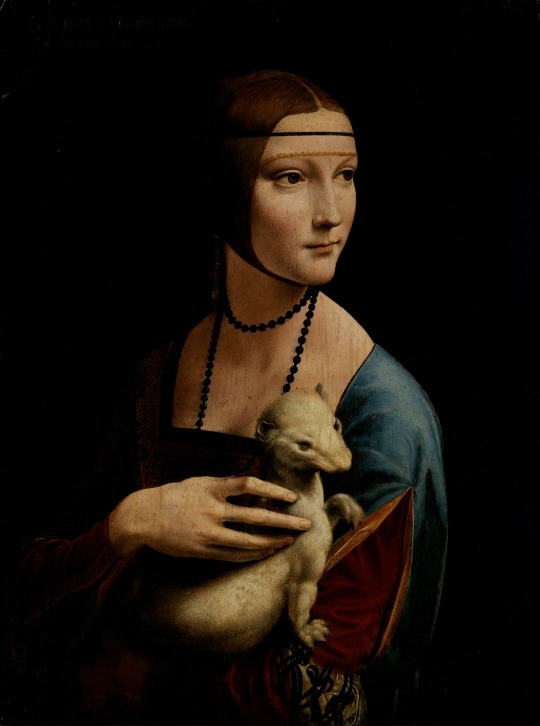
The Lady with an Ermine” (Portrait of Cecilia Gallerani), 1490, by Leonardo Da Vinci (1452-1519).
19 notes
·
View notes
Text
Lady with an Ermine
Leonardo da Vinci, 1489, Czartoryski Museum


A series of posts about pieces of art that I have used or that have inspired me to create my stories. What I will write about will deal with curiosities and interpretations regarding these works. The post is my private reflection and an encouragement to delve deeper into the topic, not a scientific treatise. This work was used in: Lady with an Ermine
The painting, painted in oil and tempera on wood, shows a portrait of Cecilia Gallerani, the young lover of Ludovico Sforza, for whom Leonardo was working at that time.
As for the appearance of the painting itself, Leonardo hesitated for a long time over its final version. At the beginning, Cecilia wasn't even holding an ermine, the background was not black, but dark blue.
It is believed that Cecilia did not hold any animal in her hands when she posed, the final version of the ermine is too large compared to the natural dimensions of this animal, so it is considered that the ermine has a symbolic meaning here.

There are several interpretations by historians of her presence. The first and most popular one refers to the fact that ermines are extremely clean animals that do not like to get their fur dirty, so it is considered an expression of the innocence and purity of Sfroza's lover.
The second one says that Ludovico Sforza used an ermine in his coat of arms, and its presence and her hand pressing the animal to her lower abdomen were to symbolize him and their son, who may have already been in her womb when Leonardo painted this painting.
From a young age he was engaged and married to a woman who strengthened his political position, but Cecilia caught his attention anyway and is believed to have become his lover when she was 16.
It is assumed that Ludovico was present himself when painting the portrait, he loved observing the sketches and Leonardo's work, for the same reason it is assumed that it is him that the model is looking at and that is why she has a bright, warm, soft and slightly pleased expression - you can see that the corner of her mouth is slightly raised.
Leonardo is a master of showing micro-expressions, as evidenced by the Mona Lisa, but in this painting he manages to capture a more innocent, delicate emotion.
The model's expression is filled with a pleasant calm - she seems happy with being painted and with her current position. She did not know then that Sforza's wife would quickly find her a husband - but this does not mean that Ludovico stopped visiting her.
In my story which refers to this painting, Aemond tells my heroine "to look to the side as if someone she had great sympathy for entered the room" - it refers to the belief that when Leonardo was painting her, she was looking at Ludovico.
17 notes
·
View notes
Text
The Portrait of Isabella d'Este, Leonardo da Vinci around 1500

Il Ritratto di Isabella d'Este, Leonardo da Vinci 1500 c.
(English / Español / Italiano)
Isabella d'Este, during a stay in Milan in 1498, saw Leonardo's portrait of Cecilia Gallerani, which he showed her. Isabella was won over by the master's hand, so much so that she wanted one for herself. A year later Leonardo fled Milan because of the victory of the French and turned back to Mantua. Isabella took advantage of the opportunity offered to her by fate, and what is more, she had the beautiful idea of pitting Giovanni Bellini against the genius Leonardo. So, she asked both artists for a portrait of her and between the two she would choose the more beautiful one. Isabella's intentions were unsuccessful, Leonardo produced two preparatory drawings and nothing more. Incidentally, one drawing was given as a gift in 1501, while the one now in the Louvre is identified with the one Leonardo took with him when he went to Venice. On the drawing there are small holes along the garments and a hand, which leads us to think that the Florentine master was ready to transfer the guiding dots onto the support that would later house the painting. The Portrait of Isabella d'Este is a preparatory drawing executed in charcoal, sanguine and yellow pastel on paper measuring 63 x 46 cm by Leonardo da Vinci, dated around 1500 and kept in the Louvre (Cabinet des Dessins) in Paris.
-----------------------------------------------------------------------------
Isabella d'Este, durante una estancia en Milán en 1498, vio el retrato de Cecilia Gallerani que Leonardo le mostró. Isabella quedó conquistada por la mano del maestro, hasta el punto de querer uno para ella. Un año más tarde, Leonardo huyó de Milán a causa de la victoria de los franceses y regresó a Mantua. Isabel aprovechó la oportunidad que le brindaba el destino y, además, tuvo la hermosa idea de enfrentar a Giovanni Bellini con el genio Leonardo. Así, pidió a ambos artistas un retrato suyo y entre los dos elegiría al más bello. Las intenciones de Isabel fueron infructuosas, Leonardo realizó dos dibujos preparatorios y nada más. Por cierto, uno de los dibujos fue regalado en 1501, mientras que el que ahora se conserva en el Louvre se identifica con el que Leonardo se llevó consigo cuando viajó a Venecia. En el dibujo se aprecian pequeños agujeros a lo largo de la ropa y una mano, lo que induce a pensar que el maestro florentino estaba preparado para transferir los puntos de guía al soporte que más tarde albergaría el cuadro. El Retrato de Isabel de Este es un dibujo preparatorio realizado en carboncillo, sanguina y pastel amarillo sobre papel de 63 x 46 cm por Leonardo da Vinci, fechado hacia 1500 y conservado en el Louvre (Cabinet des Dessins) de París.
------------------------------------------------------------------------------
Isabella d’Este durante un soggiorno milanese avvenuto nel 1498, vide il ritratto di Cecilia Gallerani eseguito da Leonardo che la stessa donna le mostrò. Isabella venne conquistata dalla mano del maestro, tanto da volerne uno per se. Un anno più tardi Leonardo fuggì da Milano a causa della vittoria dei francesi e ripiegò verso Mantova. Isabella approfittò dell’occasione offertale dal fato e in più, le venne la bella idea di mettere in competizione Giovanni Bellini con quel genio di Leonardo. Quindi, a entrambi gli artisti chiese un suo ritratto e tra i due avrebbe scelto quello più bello. L’intento di Isabella non andò a buon fine, Leonardo realizzò due disegni preparatori e nulla più. Tra l’altro, un disegno venne regalato nel 1501, mentre quello che oggi è conservato al Louvre è identificato con quello che Leonardo portò con sé quando si recò a Venezia. Sul disegno sono presenti i forellini lungo le vesti e una mano, ciò ci induce a pensare che il maestro fiorentino fosse pronto a trasferire i puntini guida sul supporto che poi avrebbe accolto il dipinto. Il Ritratto di Isabella d'Este è un disegno preparatorio eseguito a carboncino, sanguigna e pastello giallo su carta che misura 63 x 46 cm di Leonardo da Vinci, databile al 1500 circa e conservato nel Louvre (Cabinet des Dessins) a Parigi.
Source: Giovanni F. Cicchitti on Facebook
#diseño#disegno#charcoal drawing#renacimiento#renaissance#rinascimento#leonardo da vinci#louvre#16th century#s. XVI
6 notes
·
View notes
Text

“The Lady with an Ermine” (Portrait of Cecilia Gallerani) by Leonardo da Vinci, 1490
#leonardo da vinci#the lady with an ermine#15th century#art#painting#beauty#pure beauty#culture#dark academia aesthetic#italy#rome
2 notes
·
View notes
Text
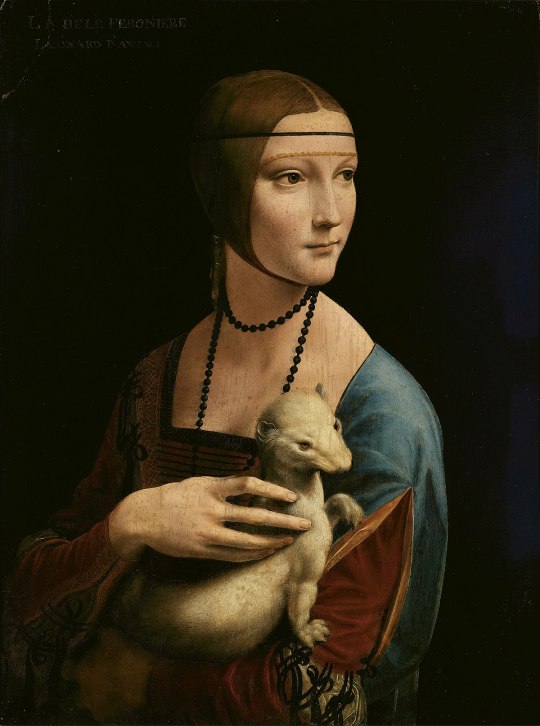
Leonardo da Vinci
Lady with ermine (1489 - 1490)
Cecilia Gallerani
The National Museum in Krakow
It is the second of only four surviving portraits of women painted by Leonardo, the others being Ginevra de' Benci, La Belle Ferronnière and the Mona Lisa.
0 notes
Text

Leonardo da Vinci The Lady with an Ermine, 1489
The Lady with an Ermine is a portrait painting widely attributed to the Italian Renaissance artist Leonardo da Vinci. Dated to c. 1489–1491, the work is painted in oils on a panel of walnut wood. Its subject is Cecilia Gallerani, a mistress of Ludovico Sforza ("Il Moro"), Duke of Milan; Leonardo was painter to the Sforza court in Milan at the time of its execution. It is the second of only four surviving portraits of women painted by Leonardo, the others being Ginevra de' Benci, La Belle Ferronnière and the Mona Lisa.
1 note
·
View note
Text

The original source of my inspiration: 'The Lady with an Ermine' is a portrait painting widely attributed to the Italian Renaissance artist Leonardo da Vinci. Dated to c. 1489–1491, the work is painted in oils on a panel of walnut wood. Its subject is Cecilia Gallerani, a mistress of Ludovico Sforza, Duke of Milan; Leonardo was painter to the Sforza court in Milan at the time of its execution. Reference: Wikipedia. Original by Leonardo da Vinci 40x55cm. Oil on walnut panel. Background overpainted.
0 notes
Photo

Leonardo Da Vinci's "Portrait of Cecilia Gallerani (Lady with the Ermine)" 🎨
#art#oil painting#da vinci#leonardo da vinci#portrait#portrait of a woman#portrait of cecilia gallerani#lady#portrait of a lady#ermine#lady with the ermine#lady with an ermine#beautiful#beauty#beautiful art
5 notes
·
View notes
Photo





Leonardo da Vinci, La dama con l’ermellino, (lady with an armine), 1490.
#leonardo davinci#la dama del armiño#la dama con l'ermellino#lady with an ermine#renaissance#italian renaissance#portrait#oil painting#italian art#famous portraits#renacimiento italiano#cecilia gallerani#milan#painting detail
26 notes
·
View notes
Text
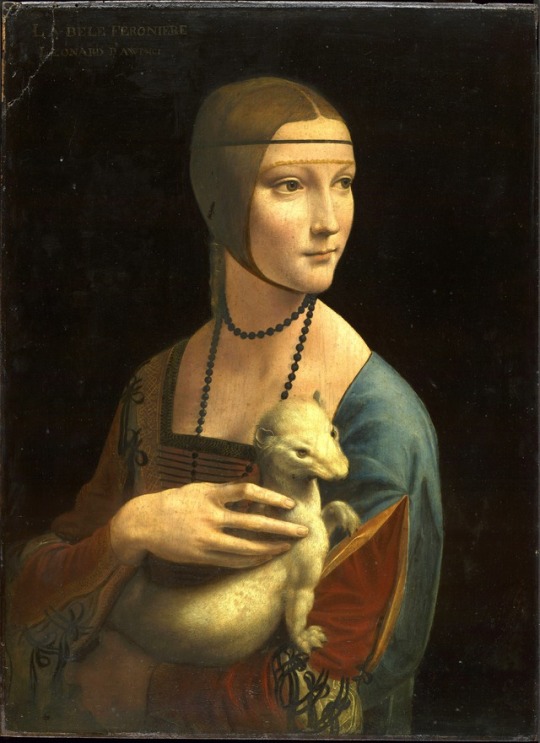
The Lady with an Ermine
Leonardo da Vinci, 1496
30 notes
·
View notes
Photo
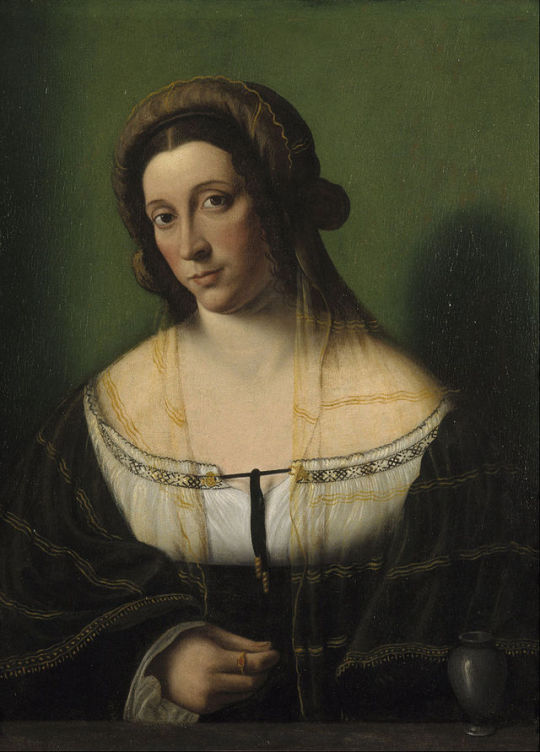
Cecilia Gallerani
2 notes
·
View notes
Text
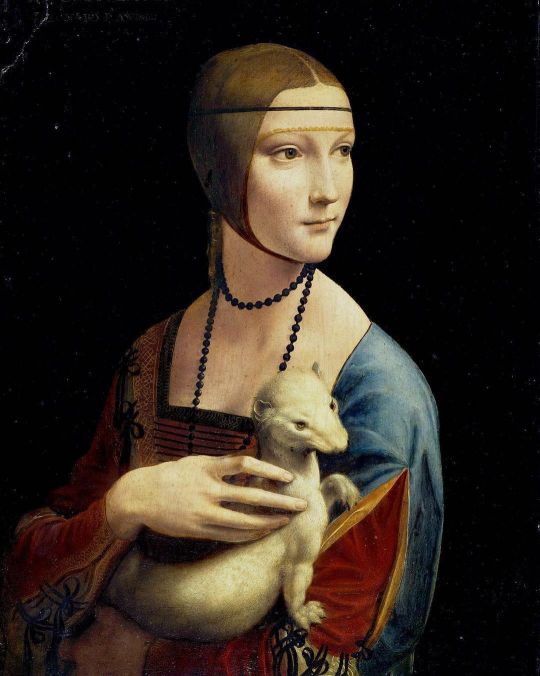
"The Lady with an Ermine" (Portrait of Cecilia Gallerani) by Leonardo da Vinci (c. 1490)
#art#art history#fine arts#oil painting#painting#paintings#leonardo da vinci#lady with an ermine#oil on canvas#art blog#portrait#portraits#ermine#history#masterpiece#portrait painting#da vinci#davinci#italian art#painter#painters#oil paintings#women in art#portrait of cecilia gallerani#cecilia gallerani
36 notes
·
View notes
Text
PORTRAIT OF CECILIA GALLERANI
(Lady with an Ermine) by Leonardo da Vinci
Leonardo da Vinci has been a favourite artist of mine since I was a child. So this was an easy choice to write about. The tougher part was which painting to choose. I have chosen this particular painting because it has a rich history. I am only going to write about half of the information that is available on this painting. I will list a few resources at the end, in case you would like to find out more about the Portrait of Cecilia Gallerani.
The portrait was commissioned by the Duke of Milan Ludovico Sforza in 1489. Leonardo was under the patronage of the very generous Duke. The reason for the commission was that Cicelia was the favourite mistress of Ludovico Sforzo.
The painting itself is in excellent condition considering the age and what is has been through. The are are a few really interesting things I find about the painting. You can still see evidence of the original sketch by Leonardo call Spoloero, on her face, right hand and arm, left hand and bridge of her nose.
Her face and other flesh areas have a large build up of paint- not surprising as Leonardo was known for layering with glazes, in order to create depth in a painting. this technique can also be seen in the Mona Lisa. Finger prints have been found on her face and the ermines head.These are thought to be da Vinci’s. The background was originally a harmonious shade of grey-blue. Later the background was painted a darker colour. There is also the idea there may have been an open window on the right hand side. The inscription on the top left is thought to have been added in the early 19th century. The body positioning of Cicelia Gallerani is not typical of the period. Her body sitting to the left with her head turned and gazing to the right, creating a sense of movement in the painting. The fact that her hand and the ermine are also facing the same direction, lead us to believe she was looking at or toward something.
The meaning of the ermine has two representations. Cicelia’s surname Gallerani is reminiscent of the Greek word for ermine “Galii”. The ermine was also the symbol of purity and moderation. The ermine, according to legend, abhorred dirt and only ate once a day. The legend also says that the ermine would rather die than sully its fur. Leonardo wrote about this in his studies of animal allegories. Towards the end of the 1480’s Ludovice Sforza adopted the ermine as part of the family emblem.
There was a sonnet published in1493, in which the painting was described by court poet Bernardo Bellincioni. This makes me wonder if Gallerani and the painting were admired. It is believed the painting remained in the possession of Cecilia Gallerani until her death in 1536.
After Cecilia’s death the painting moved around through a few different hands. 1612 it was in Prague,with Rudulf II. In the late 18th century Prince Adam Jerzy Czartoryski purchased the painting in Italy for his mother. The portrait was known to remain in the hands of the Czartoryski Princes until it went on public diplay in Krakow from 1882 to 1914. During World War I it was moved to Dresden, then back to Krakow in 1920. Im 1939 is was in possession of the Nazi’s and taken to Berlin. The painting was to earmarked for the “Fuhrer’s” Museum. Finally the portrait was liberated in 1946 and sent back to Krakow.
Since its liberation from the Nazi’s the portrait of Cecilia Gallerani has traveled to many exhibitions around the world. It is now in Krakow. This is a short version story of this painting. There is much more information about the adventures and history of this painting. I encourage you to investigate further. I have provided some links below for you to read more if you wish.
I have to give much credit for my information from the publication of “ Leonardo da Vince” The Complete Paintings, by Frank Zollner. Published by Tschen 2006
Portrait of Cecilla Gallerani (Lady with an Ermine) 1489/90
By Leonardo da Vince
Oil paint on walnut panel 55cm x 40.5cm
Krakow, Muzeum Narodowe
Czartoryski Collection
https://en.wikipedia.org/wiki/Lady_with_an_Ermine

https://www.leonardodavinci.net/lady-with-an-ermine.jsp
Youtube - Sotheby’s


#art#iloveart#painting#canadianart#artists on tumblr#oilpainting#artwork#art detail#lookingintothefuture#artist#dianabillingsart#female artists#rootoo#theatticstudio2019#movingforward#thefutureisnow#canadianartist#yeg#drawing#painter#leonardo#leonardo da vinci#lady with an ermine#renaissance
3 notes
·
View notes
Photo

ab. 1490 Leonardo da Vinci - Lady with an Ermine (Portrait of Cecilia Gallerani)
(National Museum, Kraków)
492 notes
·
View notes